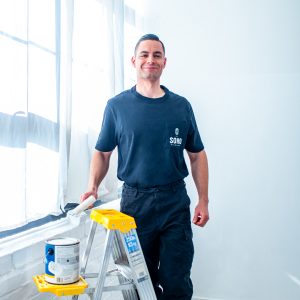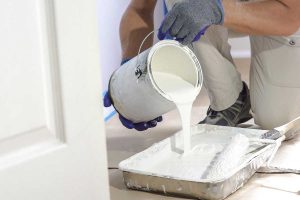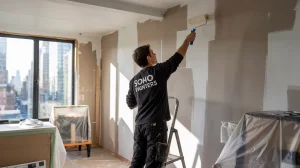Wallpapers can be an easy way to bring personality to a home because of their vibrant textures, patterns, and colors. Their upkeep is also minimal compared to paint since high-quality paper can last up to 15 years.
But as pretty as they look, their durability can also have downsides. Certain patterns and designs can make a modern home feel outdated – or they simply don’t fit your style.
If that’s the case, we won’t blame you if you want to give your home a makeover. But since removing wallpaper is time-consuming and tedious, can you paint over it instead?
We’ll weigh the pros and cons of painting over your wallpaper and give you a few tips on removing it without damaging your walls below.
Can you paint directly over the wallpaper?
Technically, you can directly paint over your wallpaper, but experienced pros will advise you against it. Sure, it reduces your time and budget on transforming your walls, but it will also drastically shorten its lifespan. Not to mention, the seams and texture of your wallpaper will peek through the paint, making it look unfinished.
Besides, vinyl, plastic film, and foil wallpapers are also a pain to paint over since their glossy surfaces make it difficult for paint to adhere to.
Probably the only exception you can consider painting over wallpaper is if removing them can damage your wall. This can happen if your walls are made of unfinished plaster or drywall.
How hard is it to remove wallpaper?
If you’re worried about how difficult it would be to remove wallpaper, the short answer is it depends on the type of wallpaper that was used.
Modern peel-and-stick wallpapers are a dream to remove because they’re designed to pull off easily from your walls. You won’t have to worry about damaging your walls since they typically don’t leave any marks.
Traditional wallpaper that needs wet glue to install is more challenging to remove since they’re designed to adhere to the surface for a long time. So, expect to use a few pieces of equipment and a lot of elbow grease to scrub them off your walls.
The type of walls you have in your house will also factor into how difficult it would be to remove wallpaper. Working with drywall is more tedious since wallpaper easily bonds to its surface. This increases the risk of damaging the surface once you remove the wallpaper. In contrast, plaster walls are easier to remove wallpaper on since they’re not as adhesive as drywall.
What’s the simplest way to remove wallpaper?
There are a couple of ways you can try to remove old wallpaper from the walls:
Vinegar and hot water
You probably heard of vinegar and water as a favorite go-to DIY cleaning solution, but you probably never thought of using it for stripping off wallpaper.
Yes, you heard that right, the easiest method of removing wallpaper involves two ingredients you probably already have in your kitchen. The warm water loosens the wallpaper glue while the acid in the vinegar dissolves it.
To use this, you just need to mix ⅓ cup of vinegar with ⅔ cup of warm water in a spray bottle and spritz it all over your walls. You might need to do it multiple times until your wallpaper is off.
Wallpaper stripper
If the homemade method doesn’t work, you might need to call in the big guns. Pros usually use a liquid wallpaper stripper for removing old wallpaper.
Note that it’s a toxic chemical, so make sure to wear a mask, gloves, and goggles to protect you from its fumes and harsh ingredients. Remember to have good ventilation when you’re doing this process.
To start, use a wallpaper scoring tool to create holes on the surface of the wallpaper. Then, apply the wallpaper stripper on the walls with a paintbrush or sponge, following the directions on the bottle. Allow it to sit on the surface for a few minutes.
You’ll know the solvent is working once the wallpaper starts to sag or pull away from the surface. Once that happens, carefully peel them off the walls.
What to do if someone painted over wallpaper?
Now that you know the repercussions of painting over wallpaper, what should you do if previous house tenants have made this mistake? Well, there’s no need to panic because you can follow the steps below:
- Roll a wallpaper-scoring tool or stiff wire brush over the walls to create scratches on the wall.
- Mix a warm water and liquid wallpaper stripper and spray the solution over the painted areas.
- Once the paint and wallpaper soften, remove them with a paint scraper or putty knife.
- Use a wallpaper steamer to loosen old wallpaper glue, then continue removing softened wallpaper chunks with a paint scraper.
- Repeat the steps until all of the wallpaper is gone. Don’t forget to clean and prep your walls before applying new paint.
How to paint walls after removing wallpaper
Once you successfully remove the wallpaper, it’s time to move on to the next phase of your project – which is to paint! But before you pick up the brush, prepping the walls will ensure a flawless finish. To do this, follow the quick guide below:
- Wipe leftover wallpaper glue, dirt, or stains with a damp towel. If stubborn, use a mild soap to scrub them off, and let the walls dry completely.
- Repair holes and cracks with wall joint compound or spackling, and allow them to dry completely.
- Sand the walls to smoothen rough textures. This ensures the paint will adhere better, and you get a perfect finish.
- Apply 1-2 coats of primer, and wait for it to dry. This will fill in uneven wall textures and help the paint last longer.
- Finally, apply 1-2 layers of paint, letting each coat dry between layers.
Need help with painting your walls?
Pass over the stress of removing your wallpapers before painting the walls to Soho Painters. They have a team of experienced painters equipped with the best tools, materials, and training to guarantee you professional results. They also offer exterior, apartment, and commercial painting to ensure your home gets the makeover it deserves. For questions or inquiries, contact their team now and book a free estimate.





